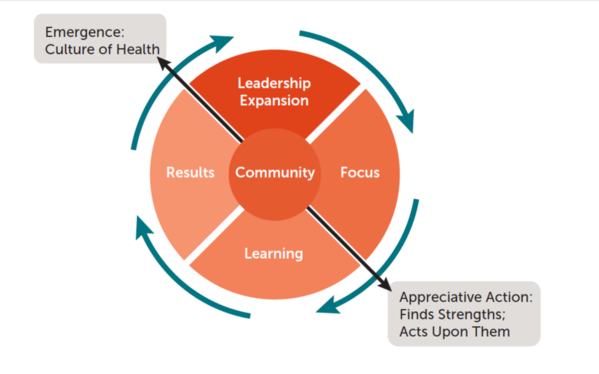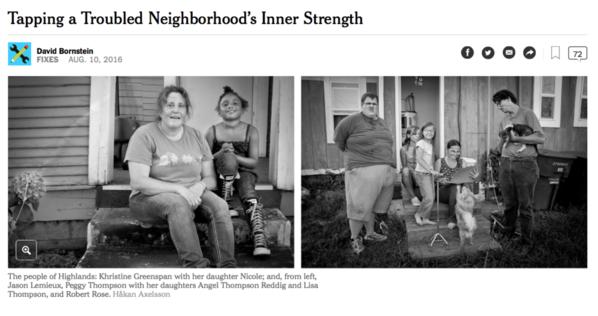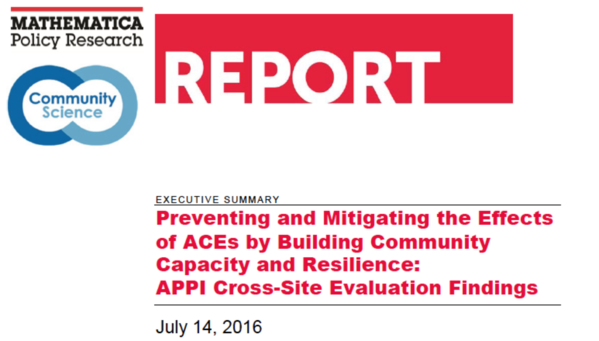As I write this, we are 10,288 strong! Sometime over the last month, we passed 10,000. Just three short years ago there were 1,000 members of ACEsConnection.
This isn't your kids' social network. We don't just yammer or tweet or FB or snapchat at each other. The people who are part of ACEsConnection are either using the knowledge of ACEs science to change themselves, their families, their organizations, their systems or their communities....or they're planning on it.
The other milestone was the publication of two must-read reports, both about communities in Washington State, with some eye-popping numbers to show that community ACEs initiatives can solve our most intractable problems.
The first: Self-Healing Communities Report, written by Laura Porter, Dr. Robert Anda and Kimberly Martin, and funded by the Robert Wood Johnson Foundation, looked at the impact of the work of the Family Policy Council network of communities that used ACEs science to solve some of their most intractable problems. Here's a highlight from the RWJF write-up:
Over 10 to 15 years in Cowlitz Co., Wash.:
Births to teen mothers went down 62% and infant mortality went down 43%;
Youth suicide and suicide attempts went down 98%;
Youth arrests for violent crime dropped 53%;
High school dropout rates decreased by 47%;
Similar results were seen in other counties.
The Self-Healing Community Model, Washington, developed strong networks that promoted much greater collaboration across sectors. They empowered local leadership and nurtured sector leaders to think about whole systems, not just their part of a system. They also used data to decide how and where to focus efforts and to learn from what was working. They made visible changes that helped to instill a real sense of hope in communities that had given up on the prospect of a better world for their children.
David Bornstein, a columnist for the New York Times, is highlighting the work of communities that are integrating ACEs science in Washington and a few other states in a three-part series (here's a link to the first: Tapping a Troubled Neighborhood's Inner Strength.)
The second report, from Mathematica Policy Research in Oakland, CA, is called: Preventing and Mitigating the Effects of ACEs by Building Community Capacity and Resilience. You can find more information here and download the report. Here are a couple of salient paragraphs:
Despite modest investments and limited staff, several rural communities in Washington State were able to weave together proven programs and innovative approaches, effectively decreasing the social, emotional, and physical problems linked to trauma.
For example, in Walla Walla, new approaches to discipline at Lincoln High School led to increases in graduation rates. In the Skagit Valley, the nurse home visits helped decrease smoking and alcohol use among expectant mothers and reduce the number of babies with low birth weight. A public awareness campaign in Okanagan County led to a 10 percentage point drop in teen drinking.
ACEsConnection members come from every state in the U.S. There are active ACEs initiatives -- either on a state level, or in counties or cities -- in Tennessee, Wisconsin, Iowa, Washington, Oklahoma, Colorado, Utah, California, Arizona, New York, North Carolina, Florida, Delaware, New Jersey, Rhode Island, Pennsylvania, Illinois, Minnesota, Michigan, Massachusetts, Maine, Ohio, Montana, Alaska, North Dakota, New Hampshire, and Washington, DC. I've probably missed some (please add them to the comments....we want to know about all!). Outside of the U.S., ACEsConnection members are integrating ACEs science in Australia, New Zealand, Scotland, Wales, England, Ireland, and many other countries.
Dozens of community groups are taking thousands of incremental steps so that all organizations and systems in communities integrate trauma-informed and resilience-building practices based on ACEs science. In other words, becoming self-healing communities. We're here to support these community groups, to highlight the practices that work, to share the tools y'all develop so that nobody has to re-invent any wheels, to provide a network for communities to use to move your work along faster, and to celebrate with stories and data.
This is still a nascent movement: There are 4,000 counties and 30,000 cities in the U.S., and hundreds of thousands of cities world-wide. We've got a ways to go, but we're growing a solid foundation.
Marshall Ganz, a long-time activist and community organizer who’s now at Harvard Kennedy School, says that social movements must have stories, structures and strategies.
The stories we all tell on ACEsConnection (and on ACEsTooHigh.com, our companion news site for the general public) provide narratives of the ACEs movement. They express its values. People open their hearts to a story in a way they just don’t open their hearts to data. But, as Ganz points out, stories are a portal to data and abstract ideas. They bring people into social movements and motivate them to take action.
ACEsConnection provides structure. It uses distributed network technology to support communities to foster the emergence of tens of thousands of community leaders who inspire a shift in the nation’s collective mental model. This new model recognizes that the roots of much of physical illness, most mental illness, and nearly all interpersonal violence are found in adverse childhood experiences that occur in families, communities and our educational, criminal justice, medical, mental health and social service systems.
Communities work across sectors to craft a new definition of health and health care in response to ACEs and their consequences, a definition that replaces shame, blame and punishment with understanding, nurturing and prevention. Community members work together across silos and across geographies, so that health becomes a part of every endeavor, and building resilience becomes part of the fabric of everyday living.
ACEsConnection also supports community members as they develop their strategies: local strategies, regional strategies, state and national strategies. The information that you bring to ACEsConnection will help institutional leaders and policy makers understand how to restructure organizations and systems so they foster health instead of reinforcing harm.
Once people learn about the consequences of ACEs, the effects of toxic stress and that trauma-informed practices and building resilience can create healthy individuals, families, communities and systems, they can never look at a homeless person without seeing an abused child. They can never look at a young man in juvenile detention without wondering why the schools he attended did not intervene in his journey from the classroom to prison. They can never look at communities without wondering if they are implementing trauma-informed and resilience-building practices; and if they are not, they ask: “How can we start?”
Thank you all for being part of this amazing community, and for continuing to ask: "How can we start?"









Comments (5)